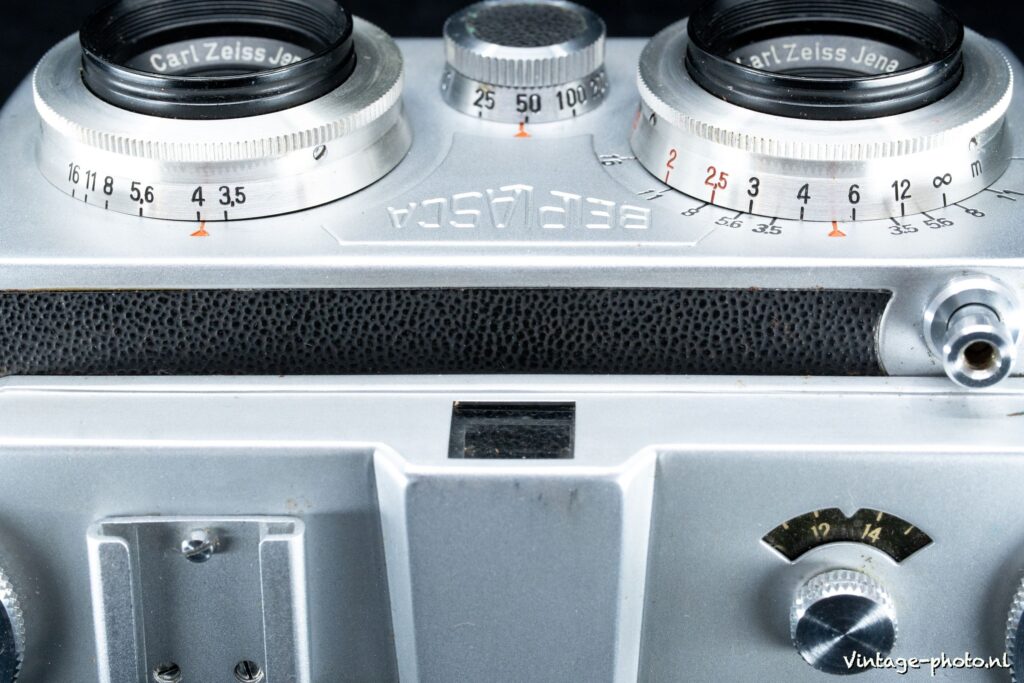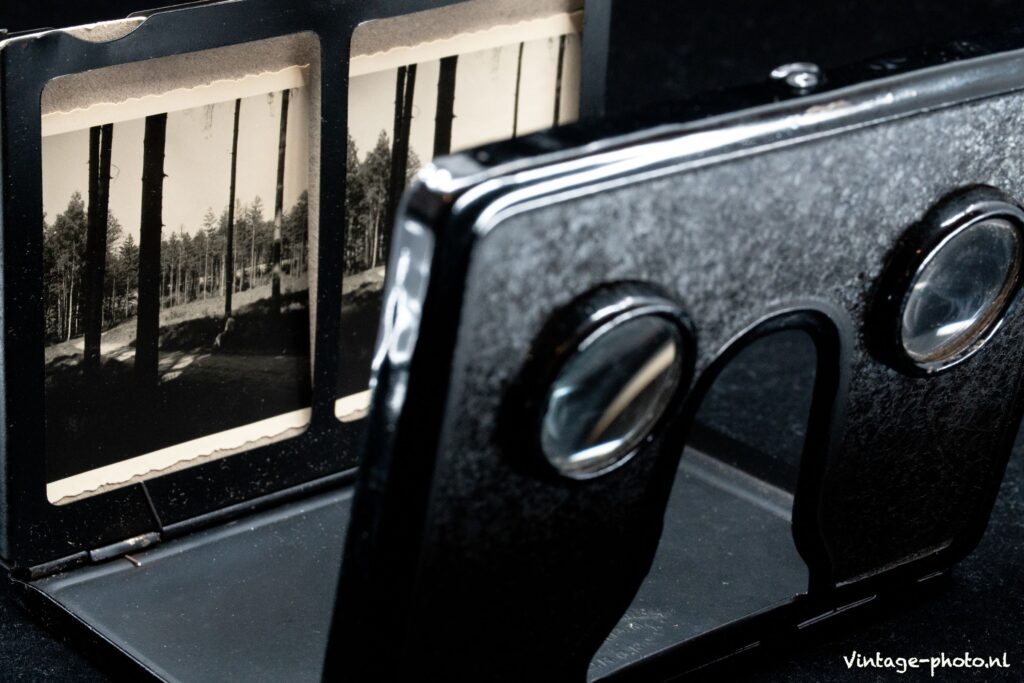It seems that stereo photography is (on its way) out. Even in cinema, the popularity of wearing 3D glasses for hours on end is declining. A pity, considering the special experience of stereography. Many also do not know that 3D photography had a real existence in analog photography. Still, there is always hope, especially if you want to experiment with top-of-the-line stereo cameras from the past. Like the legendary 35mm Belplasca, the Holy Grail of stereocameras.
Stereography is centuries old. As early as the mid-19th century, there was plenty of experimentation with stereographs that consist of two nearly identical photographs or photomechanical prints, paired to produce the illusion of a single three-dimensional image, usually when viewed through a stereoscope. Printed on paper or glass an viewed through a Viewmaster. The idea of the stereograph entailed making two images of the same subject, usually with a camera with two lenses placed 2.5 inches (6 cm) apart to simulate the position of and between the human eyes, and then mounting the positive prints side by side laterally. With a stereoscopic viewer the finished stereograph could be viewed; the stereoscope had two eye pieces through which the mounted images, placed in a holder in front of the lenses, were viewed. The two images were brought together by the effort of the human brain to create an illusion of three-dimensionality. The use of Kodachrome (film (from 1935) really boosted amateur and popular stereoscopic photography in the late 1940s – early 1950s. Kodachrome slidefilm also gave us the View-Master reels and viewers (in our childhood), which still is popular for many decades afterwards. The illusion of depth with Kodachrome slides was even achieved with the well known slide projectors and special high gain projection screens. I can remember the sweeping Saturday evenings where hours were spent with snacks and drinks presenting unendless cartridges of holiday slides to family and friends…



The first stereoscopic images were created by Sir Charles Wheatstone in 1838 using a device he called the stereoscope, which allowed two slightly different images to be viewed together in a way that created the illusion of depth and dimensionality.
However, it was not until the 1850s that stereo photography became widely popular, thanks in part to the development of new techniques for creating and viewing stereoscopic images. One of the most notable pioneers of stereo photography was the French photographer Jules Duboscq, who invented a new type of stereoscope in 1851 that allowed for more immersive and realistic 3D viewing. Throughout the late 19th and early 20th centuries, stereo photography remained a popular form of entertainment and artistic expression, with photographers and artists experimenting with new techniques and approaches to create ever-more realistic and immersive 3D images. Today, stereo photography continues to be practiced by a dedicated community of enthusiasts and professionals, using both traditional and digital techniques to create stunning 3D images.
How does it work? Stereo (as with sound left and right) takes two photographs from different horizontal positions to get a true stereoscopic image pair. Although this can done in many ways, the most interesting way is to use a special stereo camera with two (or more) side-by-side lenses attached. Stereo photography is to duplicate natural human vision and give a visual impression as close as possible to actually being there, the correct baseline for this is that the distance between the two images would be the same as the distance between the eyes (around 62-65mm). So there is a slight (horizontal) difference in the photo’s that adds to the depth illusion when viewing the pictures in a special viewer or through 3D glasses. It does not have to be (Kodachrome) transparant slides, it can also be done with photoprints.



My East-German Belplasca stereo camera from 1954 (made by VEB Werke in Niedersedlitz) has two identical high quality Carl Zeiss Jena f3.5 lenses with a focal lenght of 37.5mm lenses. The apertures range from f3.5 – f16 and the shutter speeds of 1, 2, 5, 10, 25, 100, 200th/s and B for manual. The left lens ring controls the aperture for both lenses! The right lens ring controls the focus(distance) for both lenses! Shutter times can be modified by the little wheel between the lenses. The shutter is tensioned by the slider on the right rear panel. And yes, you can even use flash bulbs and electronic flashes (sync time 1/100s).



For these cameras the closest distance from the subject for stereoscopic 3-D depth should be about 2 meters. The film (135/35mm) frame format produces pairs of 24x30mm stereo pictures ( 20-22 stereo slides per 36 exposure film). The means the Belplasca has a ingenious film transport. After all, the film between the lenses must be utilised correctly and the film cannot simply be even wound up from frame to frame. So how to use the free image field between the two image windows. The result was an uneven film advance through its perforations holes, from 7 and 20 perforation holes alternately.



This also takes some practice with inserting the film (left to right). The back panel can be removed in its entirety with the pulled out rewind button on the top left and the small lock lever on the back right. Unroll the film along the length of the back and be careful that it passes through the perforation guides in the middle of the back and then insert the film into the take up spool like any other camera. Close the back cover and set the frame counting wheel to ’18’. Then with spool and print to the ‘0’ after which the first real photo pair can be made.



It doesn’t matter which film you use. Most common for stereo images is a ‘chrome’ film. Kodachrome is known for its distinctive colors, which were saturated and vibrant, with a warm tone and high contrast. It is a complex and expensive film to manufacture and process, requiring a multi-step development process that involved precise temperature control and specialized chemicals. However, it was highly regarded for its durability and longevity, with properly stored Kodachrome slides retaining their color and image quality for decades.
Today we also have Ektachrome/Fujichrome/ or even black and white Fomapan / Adox slide film (if you really want to project the stereoslides on a screen) or just use any other 35mm film (if you want to post-process the scans yourself in a photo editor and print them out). For viewing the stereo-effect you need special glasses (or viewers or train your eyes like Daktari’s squint lion.



Two things are important for projection, a special stereo projector and special stereo slide frames for the negative pairs. For the Belplasca, there is the (rare) Belplascus V stereo projector with Ludwig Auxanar 3.5/80mm lenses (the original manual at the end). Special double slide frames were also made and are still available for the Belplasca (second hand on Ebay). For viewing you still need Carl Zeiss Stereo glasses which also are still available and they resemble the ones you use in the 3D cinema. Grab as many as you need to view with others when projecting. Of course you can also print the stereo pairs after editing them correctly (maintaining a max. distance of 65mm) next to each other and watch them through an antique (folding) stereo viewer. The editing size is depending on your viewer. One tip for the Belplasca we read on https://zeissikonveb.de/start/kameras/belplasca.html is to (cheaply) print the paper stereograms in 6×13 cm format in a drugstore. Exactly three of these stereograms 6×13 fit on top of each other on a sheet of photo paper of the standard size 13×18 cm.



Taking 3D or stereo pictures require some extra rules, besides a minimum distance to your subject from 2 meters onwards. Furthermore, the larger the depth of field, the better. This will help to make all the different layers of depth in the image be in focus, and allow you to explore them all in detail. You can achieve this with a higher F-stop (small aperture).
Also check for anything which is in front of your subject, as this may break through the ‘stereo window‘ and make it difficult to view. Sharpness (!) and good horizontal level are also vital. So a tripod and a cheap hotshoe spirit level can help with a stereo camera. For sharpness and correct exposure you best use an additional external rangefinder and light meter. The Belplasca does not have both, it is an all manual camera. You can only estimate the distance and set it with the right lens ring for both lenses.



And in case it all sounds (too) complicated, you can of course just take really good pictures with the Belplasca. The wide-angle lenses are excellent. You can also scan the negatives and turn them into funny Gifs.
About stereo photography, the Internet is full of them, there are a lot of tips and suggestions about gearing: https://www.35mmc.com/02/03/2022/an-introduction-to-stereoscopic-3d-photography-and-the-stereoscopy-blog-by-rebecca-from-stereoscopy-blog/
Belplasca winding and rewinding see the useful tutorial on https://youtu.be/Pf0RYwsvgnI
Belplasca camera history and manual: https://zeissikonveb.de/start/kameras/belplasca.html
Oh and I added my own copy of the rare Belplascus projector manual (in German).



Did you know that the 2000’s Olympic games opening ceremony was broadcasted in crosseye stereo.
It was great to watch on my standard big screen TV.
I wish there were more programs offered like this.
Thanks for the extremely interesting and comprehensive article. I have owned a Belplasca for about ten years. It is a better camera than the many American 5perf cameras with their near square format. The lack of a rangefinder is of no consequence as mentioned in the article. The tiny viewfinder and lack of a light meter are the only drawbacks in use today. The inexpensive Russian bakelike 35mm viewfinder can easily be masked down with straps of black tape to create a more usable finder. A modern clip on lightmeter is useful as well. But not both at the same time, of course! The Belplasca catalogue reproduced in the article looks fascinating, I wish I could speak German! The best viewer of stereo slides is in my opinion the American made Busch Verascope from the 1950s with a modern led bulb. I don’t quite understand the printing of colour negatives commercially into stereo pairs. Wouldn’t the machine automatically cut and print the frames as if they were 24x36mm format. I had though of selling my Belplasca, this article has changed my mind! Regards, Mark.
Belplasca was my favorite stereo camera for the last 20 years, I have several of them. It has some pros and cons but overall I think it’s the best vintage stereo camera. What I like the most is the aperture and focus rings placement. Lenses are great and 7 p format I think it’s just better choice than 5p, unless you shoot only portraits. The cons is the lack of hot shoe, unreliable pc connector and lack of strap lugs. The camera is prone to internal reflections but they can be eliminated by flocking film chambers. Foggy viewfinder can be cleaned fairly easily. The only real problem with these cameras is frozen focus. So far I wasn’t able to fix it. I tried heat and solvents. Nothing worked. Shutters are generally reliable. Lenses produce a bit of brown tinted images, they are not neutral. But sharpness and contrast are great.
I slowly moved to FED Stereo with Minolta lenses. The image quality is as good as Belplasca’s, neutral color rendition and the camera is much faster to use. I still have one Belplasca loaded with new Ektachrome, ready for action. It works best in sunny weather when can be kept at the same settings and no metering is required for every picture.